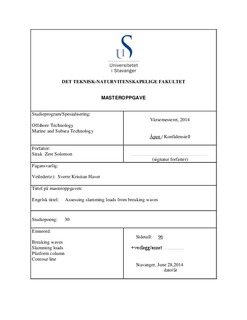| dc.contributor.author | Solomon, Sirak Zere | |
| dc.date.accessioned | 2014-09-16T09:26:07Z | |
| dc.date.available | 2014-09-16T09:26:07Z | |
| dc.date.issued | 2014-06-27 | |
| dc.identifier.uri | http://hdl.handle.net/11250/219846 | |
| dc.description | Master's thesis in Offshore technology | nb_NO |
| dc.description.abstract | Recent studies show that, the load from breaking waves gives largest impact on the platform columns. If these impacts not carefully estimated and designed, they can cause a severe damage to the platform structures. The purpose of this report is to assess these slamming loads from breaking waves on platform columns. A focus is given on how to estimate these characteristic impact loads for design control of offshore platforms.
In the first chapters a brief review of breaking wave phenomenon and the requirements for the design of offshore structures particularly the limit state functions ALS and ULS is discussed. After these introduction chapters, how a wave dominated load corresponding to annual exceedance probability of q can be estimated is given. First for linear structural system is demonstrated using some collected data and assumptions, then it is extended to nonlinear systems. In nonlinear system time-domain simulation and model based analysis is introduced.
There are two methods of estimating the slamming loads; either using model test analysis or using recommended practice from DNV-RP-C205. On this report more focuses is given to model test analysis and a brief summary of the recommended practice is given. For elaborating the model test analysis a data from collected by MARINTEK for Heidrun TLP is used. The model test was performed few years ago in Trondheim and data were collected by 56 pressure sensors that were installed on the modeled Heidrun TLP column.
In model test analysis environmental contour line approach is mainly used in this report. There are four steps in contour line analysis in order to estimating the impact load from breaking waves. The first two steps are establishing contour line of the sea states (described by Hs and Tp) having the same probability of exceedance and identifying the worst sea state from the contour line. These two methods are already done by MARINTEK. The next two steps are establishing the 3-hour maximum impact pressure distribution and estimating the q probability extreme value using α value percentile. These two steps are mainly investigated on this report. The data obtained from MARINTEK are results of different realizations for the worst sea state. Using these data two approaches are used to establish the 3-hour maximum impact pressure on the platform column. Following the environmental contour line approach, the q probability impact events are obtained by estimating the 90 % and 95% value of the 3-hour extreme impact pressure distribution. The uncertainties related to estimating this impact load are fully discussed with the help of bootstrapping.
The result obtained from direct and indirect approaches is slightly different especially when we consider high α percentile from the distribution curve. Since indirect method considers the number of impact per test on estimating the impact load, it is relatively accurate than the direct approach.
Finally the investigation is extended to see how the area considered will affect the distribution of the 3-hour maximum values. The area is enlarged to vertical and horizontal directions by adding two sensors on their sides. It is found out that, as the considered sensor area increases the average pressure obtained decreases. On the other hand if the area of sensor decreases the impact pressure increases but there is possibility of missing the local peak force. | nb_NO |
| dc.description.sponsorship | University of Stavanger | nb_NO |
| dc.language.iso | eng | nb_NO |
| dc.publisher | University of Stavanger, Norway | nb_NO |
| dc.subject | undervannsteknologi | nb_NO |
| dc.subject | konstruksjonsteknikk | nb_NO |
| dc.subject | breaking waves | nb_NO |
| dc.subject | slamming loads | nb_NO |
| dc.subject | platform column | nb_NO |
| dc.subject | contour line | nb_NO |
| dc.subject | offshore teknologi | nb_NO |
| dc.title | Assessing slamming loads from breaking waves | nb_NO |
| dc.type | Master thesis | nb_NO |
| dc.subject.nsi | VDP::Technology: 500::Marine technology: 580::Offshore technology: 581 | nb_NO |
| dc.source.pagenumber | 96 | nb_NO |
